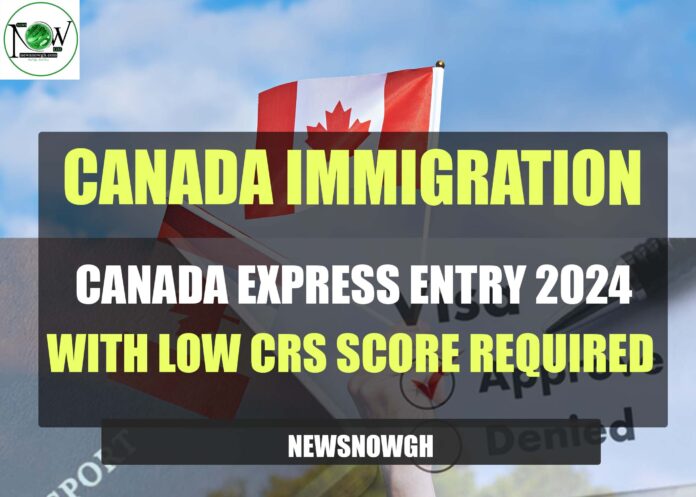Canada Express Entry 2024 with LOW CRS Score Required | Canada Immigration
We’ll discuss the recent IRCC invites to 3,200 applicants in the French language proficiency Express Entry draw in this piece. To acquire all the facts, pay close attention and read the article through to the finish.
IRCC Invites 3,200 Candidates
This month’s fourth Express Entry draw comprises invitations to apply (ITAs) from Immigration, Refugees and Citizenship Canada (IRCC). In a category-based selection draw, the department awarded 3,200 ITAs to candidates who could speak French. For consideration, these applicants needed to have a minimum Comprehensive Ranking System (CRS) score of 420.
The three draws from last week, which took place between July 2 and July 5, are closely followed by the draw today. In a Provincial Nominee Program (PNP) only draw held on July 2, 920 candidates were invited; to be eligible, candidates had to have a minimum CRS score of 739. Draws for selection based on categories were held in the other two. 1,800 ITAs were sent out to candidates in trade vocations on July 4th, while 3,750 invitations were sent out on July 5th.
All in all, Express Entry draws have been quite active this month. The IRCC normally conducts two to four draws per month, on average, every other week. With six draws, February was the busiest month of the year thus far. April was the last month to have four draws.
This year’s category-based selection draws are anticipated to award 30% of the ITAs in French proficiency draws. 15,600 ITAs have been given out by the IRCC to qualified applicants in this category thus far.
What is Express Entry?
The Federal Skilled Worker Program (FSWP), the Canadian Experience Class, and the Federal Skilled Trades Program are the three primary economic immigration categories for which the Immigration and Refugee Committee (IRCC) administers applications. To choose immigration applicants with the best potential of assimilating into Canada’s labor and economy, it was introduced in 2015.
Although the eligibility requirements for each Express Entry program vary, the Comprehensive Ranking System (CRS) is used to assess all applicants. Candidates are given numerical scores by the CRS based on many characteristics such as age, occupation, job experience, education, and language proficiency.
An overall CRS score is created by adding these scores together. A candidate’s chances of receiving an ITA from the IRCC in a future Express Entry draw increase with their score.
What is Category-Based Selection?
In 2023, the IRCC instituted category-based selection draws to identify potential applicants capable of covering critical labor shortages. Following discussions with pertinent parties and the provincial and territorial governments, the six categories were selected. The categories as of right now are:
- Science, Technology, Engineering, and Mathematics (STEM) professions
- Agriculture and Agri-food occupations
- Healthcare occupations
- Transport occupations
- Trade occupations, such as carpenters, plumbers, and contractors
French language proficiency
These classifications will stay in effect until 2025, at which time they might be modified to better reflect the needs of the labor market. Candidates must have at least six months of relevant work experience in a profession that is classified under an applicable National Occupational Classification (NOC) code to be considered for all categories, except French proficiency.
Candidates who speak French must have results from the Niveaux de compétence linguistique canadiens (NCLC) in reading, writing, speaking, and listening that show a minimum score of seven.
Summary of Recent Express Entry Draws
- July 2nd Draw: 920 individuals with a minimum CRS score of 739 were invited to a Provincial Nominee Program (PNP) only draw.
- July 4th Draw: 1,800 ITAs were given to applicants for trade jobs.
- July 5th Draw: 3,750 candidates for jobs in healthcare were invited.
- July 10th Draw: 3,200 ITAs with a minimum CRS score of 420 were given to those who could speak French.
Benefits of Express Entry
The goal of Express Entry is to expedite the immigration process for talented professionals who have the best chance of succeeding in Canada. The majority of applications are processed by the effective system in less than six months. Additionally, it gives candidates an easy-to-use method to determine how likely they are to receive an ITA based on their CRS score.
Key Features
- Quick Processing: The majority of applications are finished in six months or less.
- Transparency: Applicants can view their CRS score and determine how likely they are to receive an invitation.
- Flexibility: By obtaining new certifications or job experience, candidates can raise their CRS score.
How to Improve Your CRS Score
You can raise your CRS score to increase your chances of getting an ITA. Among the tactics are:
- Enhancing Language Proficiency: A higher CRS score can be obtained by taking language examinations with higher scores.
- Acquiring Work Experience: You can improve your score by gaining more work experience, particularly in skilled occupations.
- Additional Education: Getting more education will help you score higher on the CRS.
- Provincial Nominee Program (PNP): By having a province nominate you, you can raise your CRS score by 600 points, virtually ensuring you get into the ITA.
Conclusion
Skilled workers can come to Canada through the very transparent and effective Express Entry procedure. You can raise your chances of getting an ITA by being aware of the system and taking action to raise your CRS score. Keep up with the most recent draws and think about focusing on particular categories to satisfy Canada’s labor market demands.
Follow us on Newsnowgh.com to stay updated on the latest information regarding work permits, visa application processes, paths to permanent residency, and visa-sponsored employment.


